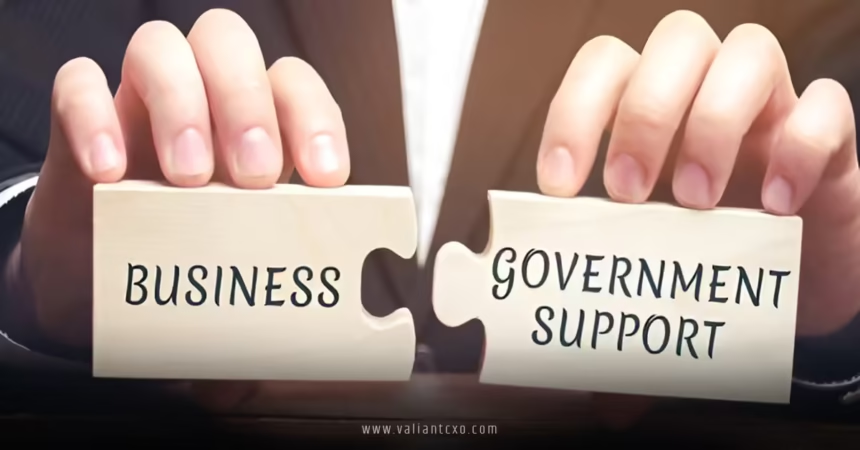Government Policies Supporting U.S. Small Businesses are the unsung heroes behind the success of countless entrepreneurs. Imagine a small business as a seedling in a vast forest—without the right nutrients, it struggles to grow. That’s where government policies come in, acting like sunlight and water to nurture these budding enterprises. Small businesses are the heartbeat of America’s economy, making up 99.7% of all companies and employing nearly half of the private workforce. So, how does the government ensure these vital players thrive? Let’s dive into the world of federal support, from loans to tax breaks, and explore how Government Policies Supporting U.S. Small Businesses are shaping a brighter future for entrepreneurs.
Why Small Businesses Need Government Support
Running a small business isn’t a walk in the park. From securing capital to navigating regulations, entrepreneurs face a mountain of challenges. The government recognizes this and steps in with policies designed to level the playing field. Why? Because small businesses drive innovation, create jobs, and keep local communities vibrant. Without Government Policies Supporting U.S. Small Businesses, many would drown under financial pressures or bureaucratic red tape. These policies aren’t just handouts—they’re strategic investments in the nation’s economic engine.
The Economic Impact of Small Businesses
Picture a bustling Main Street with mom-and-pop shops, cafes, and startups. These businesses don’t just sell goods; they create ripple effects. According to the U.S. Small Business Administration (SBA), small businesses account for over 70% of net new jobs since 2019. They’re the spark plugs igniting economic growth, especially in underserved communities. Government Policies Supporting U.S. Small Businesses ensure these sparks keep firing, fostering resilience and opportunity.
Key Government Policies Supporting U.S. Small Businesses
The U.S. government has a toolbox full of programs to help small businesses flourish. From financial aid to training, these initiatives are designed to address every stage of a business’s journey. Let’s break down the most impactful Government Policies Supporting U.S. Small Businesses.
Small Business Administration (SBA) Programs
The SBA is like a trusty guide for small business owners, offering a lifeline through various programs. Established in 1953, the SBA’s mission is to aid, counsel, and protect small businesses. Here’s how it delivers:
SBA Loan Programs
Need cash to start or grow your business? The SBA doesn’t lend money directly but guarantees loans through banks, making it easier for entrepreneurs to secure funding. The 7(a) Loan Program, for instance, offers up to $5 million for working capital, equipment, or expansion. In 2021, the SBA delivered $44.8 billion through over 61,000 loans, with significant portions going to minority- and women-owned businesses. These loans are a game-changer, reducing the risk for lenders and opening doors for entrepreneurs.
Disaster Assistance
When disaster strikes—think hurricanes, floods, or pandemics—small businesses often take the hardest hit. The SBA’s Disaster Loan Program provides low-interest loans to help businesses rebuild or keep operations running. During the COVID-19 crisis, the SBA distributed over $1 trillion in relief funds, including the Paycheck Protection Program (PPP), which helped businesses retain employees and cover overhead costs. Government Policies Supporting U.S. Small Businesses like these act as a safety net, ensuring businesses can weather the storm.
Counseling and Training
Knowledge is power, and the SBA delivers it through free counseling and training. Partnering with organizations like SCORE, the SBA offers mentorship and workshops to help entrepreneurs navigate everything from business plans to marketing. Imagine having a seasoned mentor by your side, guiding you through the entrepreneurial jungle—that’s what the SBA’s counseling services provide.
Tax Credits and Incentives
Who doesn’t love a tax break? Government Policies Supporting U.S. Small Businesses include a variety of tax credits to ease financial burdens. The American Rescue Plan, for example, extended the Employee Retention Credit and Paid Leave Credit, helping businesses keep workers on payroll during tough times. Additionally, the Affordable Care Act offers tax credits for small businesses providing health insurance, covering up to 35% of costs for firms with fewer than 25 employees. These incentives are like a financial high-five, rewarding businesses for investing in their teams.
Federal Contracting Opportunities
The government is the world’s largest buyer, spending over $500 billion annually on goods and services. Government Policies Supporting U.S. Small Businesses ensure a slice of that pie goes to small firms. The SBA’s 8(a) Business Development Program helps disadvantaged businesses compete for set-aside contracts, while the HUBZone program targets firms in underutilized areas. Each year, the government aims to award at least 3% of federal contracting dollars to Service-Disabled Veteran-Owned Small Businesses (SDVOSB) and 10% to Small Disadvantaged Businesses (SDB). These policies open doors to lucrative contracts, helping small businesses scale.
Innovation and Research Programs
Got a groundbreaking idea? The Small Business Innovation Research (SBIR) and Small Business Technology Transfer (STTR) programs are like rocket fuel for tech-driven startups. These initiatives provide non-dilutive funding—up to $275,000 in Phase I and $1 million in Phase II—to help small businesses develop and commercialize innovative technologies. In 2021, nearly 7,000 awards were given, supporting over 65,000 jobs. Government Policies Supporting U.S. Small Businesses in research and development ensure America stays at the forefront of innovation.
The Role of Government Policies in Post-COVID Recovery
The COVID-19 pandemic was a gut punch for small businesses. Restaurants closed, retailers struggled, and startups faced uncertainty. Government Policies Supporting U.S. Small Businesses played a critical role in the recovery. The Paycheck Protection Program (PPP) and Economic Injury Disaster Loans (EIDL) provided billions in relief, helping businesses stay afloat. The Restaurant Revitalization Fund and Shuttered Venue Operators Grant targeted hard-hit industries like food service and entertainment. These policies weren’t perfect—fraud was a challenge—but they kept countless businesses from going under.
A Surge in Entrepreneurship
Here’s a silver lining: the post-COVID economy sparked an entrepreneurial boom. In 2024, the U.S. averaged 430,000 new business applications per month, a 50% increase from 2019. Why? Government Policies Supporting U.S. Small Businesses, like the State Small Business Credit Initiative (SSBCI), made capital more accessible. The SSBCI allocated billions to states and tribes, with $3 billion dedicated to equity and venture funding. This surge shows that with the right support, Americans are eager to chase their entrepreneurial dreams.
Challenges and Opportunities for Improvement
No system is flawless. While Government Policies Supporting U.S. Small Businesses have made strides, gaps remain. Fraud in COVID relief programs exposed weaknesses in oversight, with the Department of Justice investigating numerous cases. The SBA also lacks clear policies for veteran-owned businesses, despite legal mandates. And in underserved communities, access barriers persist, particularly for rural and minority-owned firms.
Addressing Fraud and Oversight
Fraud is like a weed in the garden of government aid—it can choke out legitimate businesses. The SBA is working to improve access to external data, like tax records, to catch fraudsters early. Better coordination between agencies could also streamline oversight, ensuring funds reach those who need them most.
Enhancing Access for Underserved Communities
Not every entrepreneur has equal access to resources. Rural businesses, for example, may struggle to navigate federal programs. Government Policies Supporting U.S. Small Businesses are evolving to address this, with initiatives like the Community Navigators Pilot Program, which awarded $100 million to connect underserved entrepreneurs with resources. More work is needed to ensure every community benefits.
The Future of Government Policies Supporting U.S. Small Businesses
What’s next for small business support? The rise of fintech and AI is transforming how businesses access capital, and the government is taking note. A recent Treasury Department brief highlighted the need for uniform disclosures in financing products, making it easier for entrepreneurs to compare options. Government Policies Supporting U.S. Small Businesses will likely focus on leveraging technology to simplify processes and foster inclusivity.
Embracing Technology and Innovation
Think of technology as a bridge connecting small businesses to opportunities. Programs like the International Trade Administration’s (ITA) eCommerce resources help businesses go digital, while the STOPfakes program protects intellectual property abroad. As small businesses adapt to a tech-driven world, government policies must keep pace, offering tools to navigate new landscapes.
Strengthening Local Ecosystems
Local communities are the soil where small businesses grow. Government Policies Supporting U.S. Small Businesses are increasingly partnering with state and local governments to create robust ecosystems. For example, the Community Development Financial Institutions (CDFI) Fund supports lenders serving low-income areas, while state-level programs like Illinois’ infrastructure grants provide targeted aid. These partnerships amplify federal efforts, ensuring support reaches every corner of the country.
Conclusion
Government Policies Supporting U.S. Small Businesses are more than just programs—they’re a lifeline for dreamers, innovators, and job creators. From SBA loans to tax credits, federal contracting to disaster relief, these policies empower entrepreneurs to overcome challenges and seize opportunities. They’ve fueled a post-COVID entrepreneurial surge, created millions of jobs, and kept communities thriving. But there’s room to grow—addressing fraud, improving access, and embracing technology will make these policies even stronger. So, if you’re a small business owner or aspiring entrepreneur, take heart: the government has your back. Dive into these resources, tap into the support, and let your business soar. The American dream is alive, and Government Policies Supporting U.S. Small Businesses are here to help you chase it.
FAQs
What are the main Government Policies Supporting U.S. Small Businesses?
Government Policies Supporting U.S. Small Businesses include SBA loan programs, tax credits like the Employee Retention Credit, federal contracting opportunities like the 8(a) program, and innovation funding through SBIR/STTR. These initiatives provide financial, technical, and contracting support.
How can small businesses access SBA loans?
Small businesses can apply for SBA loans through participating banks or credit unions. The SBA guarantees a portion of the loan, reducing lender risk. Visit SBA.gov for eligibility details and application steps.
Are there Government Policies Supporting U.S. Small Businesses for disaster recovery?
Yes, the SBA’s Disaster Loan Program offers low-interest loans to businesses impacted by natural disasters or economic crises like COVID-19. The Paycheck Protection Program was another key policy for pandemic recovery.
How do tax credits benefit small businesses?
Tax credits, like those in the American Rescue Plan, reduce costs for small businesses by offsetting expenses for employee retention or health insurance. These Government Policies Supporting U.S. Small Businesses encourage investment in workforce and growth.
Where can I learn more about federal contracting for small businesses?
The SBA’s contracting programs, like HUBZone and 8(a), help small businesses secure federal contracts. Check HHS.gov or Grants.gov for details on eligibility and opportunities.
For More Updates !! : valiantcxo.com


